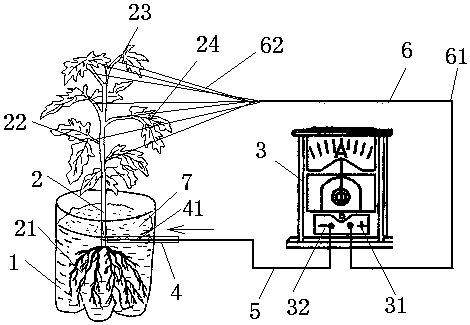Pulse electrophoresis-assisted Agrobacterium-mediated plant transgenic method and device
An Agrobacterium-mediated, pulsed electrophoresis technology, applied in the field of bioengineering, can solve problems such as plants without integrated receptors, and achieve the effects of improving the efficiency of gene transformation and shortening the experimental period.
- Summary
- Abstract
- Description
- Claims
- Application Information
AI Technical Summary
Problems solved by technology
Method used
Image
Examples
Embodiment 1
[0025] Example 1, taking the Vinca minor plant as the recipient plant, converting the exogenous gene into the chitinase gene from tobacco
[0026] In this example, a pulse electrophoresis-assisted transgenic test was carried out on Vinca minor plants, and the transformed exogenous gene was chitinase gene from tobacco. The Vinca minor seedlings used in this example come from our laboratory.
[0027] This embodiment includes the following steps:
[0028] Step 1, excavating 20 robust vinca seedlings from the field as receptors;
[0029] Step 2, shaking and culturing the Agrobacterium solution containing the chitinase gene on a shaker, so that the OD value reaches 0.6;
[0030] The Agrobacterium solution obtained in step 3 and step 2 is centrifuged at 3500 rpm for 2 minutes, then resuspended with MS0 liquid medium with a pH of 5.2, and finally adding 200 μM acetosyringone to the suspension to obtain a transformation solution;
[0031] Step 4, inserting the rooted recipient plan...
Embodiment 2
[0037] Example 2, taking Mongolian leek as the recipient plant, converting the exogenous gene into the chitinase gene from tobacco
[0038] In this example, a pulse electrophoresis-assisted transgenic experiment was carried out on the plants of Chinese chives, and the exogenous gene to be transformed was the chitinase gene from tobacco. The Mongolian leek seedlings used in this example come from this laboratory.
[0039] This embodiment includes the following steps:
[0040] Step 1: Excavating 35 healthy Mongolian leek seedlings from the field as recipients;
[0041] Step 2, shaking and culturing the Agrobacterium solution containing the chitinase gene on a shaker to make the OD value reach 0.4;
[0042] The Agrobacterium solution obtained in step 3 and step 2 was centrifuged at 3400 rpm for 1.5 minutes, then resuspended with MS0 liquid medium with a pH of 5.1, and finally added 160 μM acetosyringone to the suspension to obtain a transformation solution;
[0043] Step 4, in...
Embodiment 3
[0049] Example 3, using Atractylodes macrocephala as the recipient plant, converting the exogenous gene into the chitinase gene from tobacco
[0050] In this example, a pulse electrophoresis-assisted transgenic test was carried out on Atractylodes macrocephala plants, and the transformed exogenous gene was chitinase gene from tobacco. The Atractylodes macrocephala seedlings used in this example come from our laboratory.
[0051] This embodiment includes the following steps:
[0052] Step 1, excavating 30 strong Atractylodes macrocephala seedlings from the field as recipients;
[0053] Step 2, shaking and culturing the Agrobacterium solution containing the chitinase gene on a shaker, so that the OD value reaches 0.8;
[0054] The Agrobacterium solution obtained in step 3 and step 2 was centrifuged at 3800 rpm for 3 minutes, then resuspended with MS0 liquid medium with a pH of 5.4, and finally 190 μM of acetosyringone was added to the suspension to obtain a transformation solu...
PUM
 Login to View More
Login to View More Abstract
Description
Claims
Application Information
 Login to View More
Login to View More - R&D
- Intellectual Property
- Life Sciences
- Materials
- Tech Scout
- Unparalleled Data Quality
- Higher Quality Content
- 60% Fewer Hallucinations
Browse by: Latest US Patents, China's latest patents, Technical Efficacy Thesaurus, Application Domain, Technology Topic, Popular Technical Reports.
© 2025 PatSnap. All rights reserved.Legal|Privacy policy|Modern Slavery Act Transparency Statement|Sitemap|About US| Contact US: help@patsnap.com

